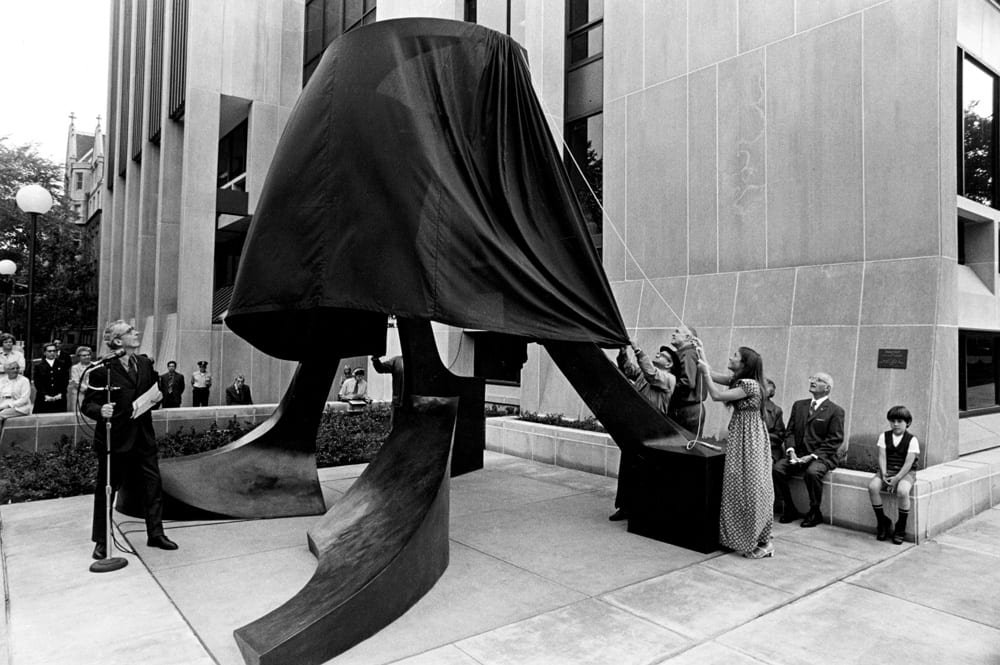UChicago's Art in Public Spaces featured in WTTW's Chicago Mysteries with Geoffrey Baer
Wolf Vostell, Concrete Traffic, 1970. Campus Art Collection, The University of Chicago. Photo by Michael Tropea. Art © The Wolf Vostell Estate.
WTTW’s new television special Chicago Mysteries aims to solve the burning questions surrounding Chicago’s most intriguing landmarks, including public artworks on the University of Chicago’s campus: The Dialogo Sculpture, Nuclear Energy, and Concrete Traffic.
The Dialogo sculpture
Virginio Ferrari’s Dialogo lives just around the corner from the Main Quadrangles next to Albert Pick Hall for International Studies. This sculpture made of bronze and limestone was installed in 1971 and was created in honor of Chicago businessman Albert Pick Jr..
Photograph of Albert Pick’s granddaughter, Pauline Ross, unveiling Dialogo. University of Chicago Photographic Archive, apf2-07277r, Special Collections Research Center, University of Chicago Library
Chicago Mysteries examines the sculpture for a “hidden political meaning.” Rumors have it that every first day of May the sculpture casts a shadow in the shape of a hammer and sickle. The host of Chicago Mysteries, Geoffrey Baer investigates with an interview with the sculptures creator, Virginio Ferrari. Watch here.
Learn more about Dialogo and its history here at the University of Chicago’s Art in Public Spaces website.
Nuclear Energy
Another Chicago Mystery that’s investigated with ties to Public Art at UChicago is “Why is the world’s first nuclear reactor buried in a forest preserve?” Radio-active materials from the first ever nuclear reactor were buried at a forest preserve in southwest Cook County with the site marked by a block reading “Caution – Do not dig. Buried in this area is radioactive material from nuclear research conducted here 1943-1949.” You can watch Geoffrey Baer find out why the materials were buried miles away from the first nuclear reaction site here.
The first self-sustaining nuclear chain reaction took place at the University of Chicago under the bleachers of Stagg Field in 1942. In 1967, a twelve-foot tall bronze sculpture was commissioned by the University of Chicago to commemorate the accomplishment of the scientists involved in this historic achievement. Henry Moore’s Nuclear Energy is located next to the The Joseph Regenstein Library on Ellis Avenue between 56th and 57th Streets.
Henry Moore, Nuclear Energy, 1967. Photo by Tom Rossiter.
Learn more about the history of the first nuclear reaction and the sculpture at the University of Chicago’s Art in Public Spaces website.
Concrete Traffic
Originally commissioned by the Museum of Contemporary Art (MCA), Concrete Traffic was created by Fluxus artist Wolf Vostell and installed in 1970. The MCA gifted Concrete Traffic to the University of Chicago only a few months after. It is now located at Campus North Parking Garage, 5525 S Ellis Ave, on view for all who pass by.
More about this public art sculpture is discussed in an online-exclusive Chicago Mysteries that investigates another of Wolf Vostell’s works that exists in special collections at UChicago. Concrete Book #83 is one of one-hundred slabs of concrete that purportedly encases a copy of Vostell's book called Betonierungen, or Concretifications. Watch as Geoffrey Baer and UChicago’s Special Collections Manager Patti Gibbons find out whether or not there exists a manuscript in the slab of concrete art here.
Find out more about the history of Vostell’s works at the University of Chicago: Concrete Traffic and Concrete Book #83.
Geoffrey Baer on location for Chicago Mysteries. Photo by Liz Markel for WTTW.
You can watch the entire episode of WTTW’s Chicago Mysteries with Geoffrey Baer and dig into more mysteries including a supposed Salvador Dalí painting that baffled curators at the Art Institute, how an alligator got into the Chicago Lagoon, and more at the Chicago Mysteries website! And you learn more about the Art in Public Spaces that live in on the University of Chicago’s campus at publicart.uchicago.edu.




